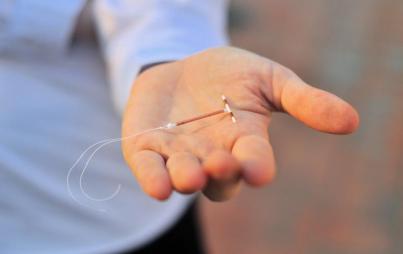
See what we did there?
I got my tubes cauterized. I’m so very glad I was asleep, because that’s not a smell I want any memory of.
You know 1,000 people. Maybe not closely, but if you combine your different circles, then you probably do. Eleven of those people could be having a surprise baby, despite years of thinking they were safe.
When did I discover that sterilization isn’t as cut and dry as it seems? While sitting in a hospital gown, signing my life away, awaiting surgery. Five papers, as I recall, said that getting my tubes tied was not 100% effective at preventing pregnancy. I was confused then, and I'm confused now. Wasn’t that the whole point of getting the operation? The nurse laughed. The doctor laughed. I did not.
Sterilization is a procedure in which the fallopian tubes are closed or blocked, resulting in the most "permanent" kind of birth control there is (more on those quotation marks later). I can't use hormonal birth control, thanks to a lifetime of brutal migraines. I'm only sleeping with one person and not planning any changes there, so pregnancy is my only worry. Mostly, though, I just know I'm done. No chance I can handle another kid, not if I want to stay even semi-sane.
Four years after having the procedure done, I was reminded of that unfunny moment with the doctor and nurses . . . because I had a separate unfunny moment. I missed my Extremely Normal period.
It wasn't late. I missed it. I read a lot and freaked out, as a person tends to do when she has access to high-speed Internet late at night. Among the things I read: More than 1% of women who have their tubes tied still get pregnant.
No, I kept saying. No, because that is how pregnancy happens, right? Just based on how many times you repeat Yes or No to yourself.
Once a horrible thought enters my mind, it doesn’t go away. So I bought a pregnancy test on my way to work one night. I snuck out while my adult students were working on a writing assignment, and I peed on a stick.
It didn’t change in the first minute, but I couldn’t be gone too long, so I shoved the still-calculating time bomb, along with a nice urine splash on the handle, into my pocket.
I kept peeking at my pee stick during the next 10 minutes of class, sure everyone knew exactly what was going on. It was still negative by the time I tossed it in the trash two hours after class was finished.
Two weeks later, still no news on the menstrual front. No pink plus sign on any brand of pregnancy test, either. I finally make an appointment with my nurse practitioner.
She’s unimpressed with my fears. One percent seems like nothing to her. She doesn’t think there’s any chance I’m preggo. Apparently bodies are weird — who knew? Before I leave, though, the assistant wants to be absolutely sure. I feel like she knows someone in the 1%.
Peeing in a legit cup rather than all over myself while aiming for a stick, I’m sick to my stomach. Not like I want to throw up, but like my stomach is eating itself. I’m devoid of emotion. I can’t do this. I already have two ‘surprise’ children, which is why I got my tubes annihilated in the first place.
Twenty-three seconds or so later, it is confirmed:
not pregnant.
I leave the office and commit to never having sex again.
Despite my post-op pregnancy scare, there are many things about getting a tubal ligation (the fancy phrase for "getting your tubes tied") that all the medical journals, health magazines, and scary Internet articles don't tell you. That said, I'd like to introduce you to five things you might not have known — and that I found out — about this "permanent" form of birth control:
1.1.1%. That’s 11 people — 11 real women — out of every thousand who end up getting pregnant even after having this medical procedure done to them. It requires general anesthesia and everything!
2. Your fallopian tubes can best be accessed for surgical intervention through the belly button. It leaves no scar, unless you can somehow see back there in the dark crevasse. This does not matter much to me since I already have a scar on my navel, thanks to an at-home, ice-assisted, self-piercing of this very same belly button. No alcohol was ingested or applied to the button for sterilization.
3. They don't call it 'tying' anymore, nor is there actual tying involved (unless your gynecologist fancies herself a Girl Scout needing to practice her knots). They say 'ligation,' which just makes me think of litigation going on above my uterus. That’s not quite right, either. I got my tubes cauterized. I’m so very glad I was asleep, because that’s not a smell I want any memory of.
4. It might be your best option. I was the last appointment of the day, plus another hour late because babies don’t seem to understand the concept of arriving at scheduled times. The midwife gets out the IUD kit, sets up, and then thinks maybe she should check on my insurance.
When she gets back, I’m grumpy, cold, and half naked. “Blue Cross has to do a pre-authorization. And it is too late to call today. Sorry.”
So I get dressed, walk to the front desk, and make an appointment for the $10,000-all-told surgery for two weeks in the future. The insurance company pays 100% without requiring anything — no phone call, no letter, no exam.
It strikes me that this situation does not make any sense and perhaps this is why the healthcare system is in crisis.
5. After it’s all said and done, you will still remain angry at your husband for refusing to just get a damn vasectomy.







